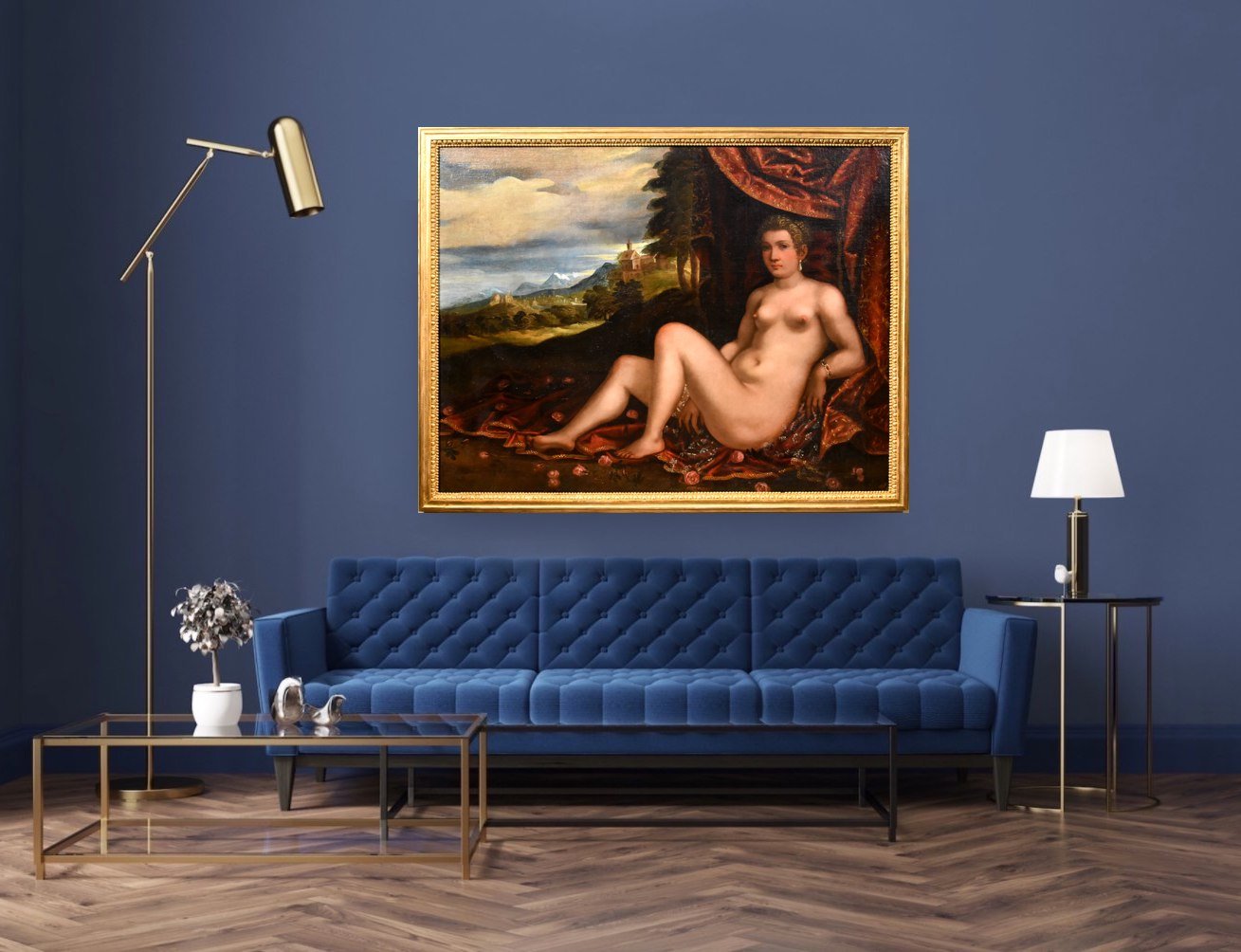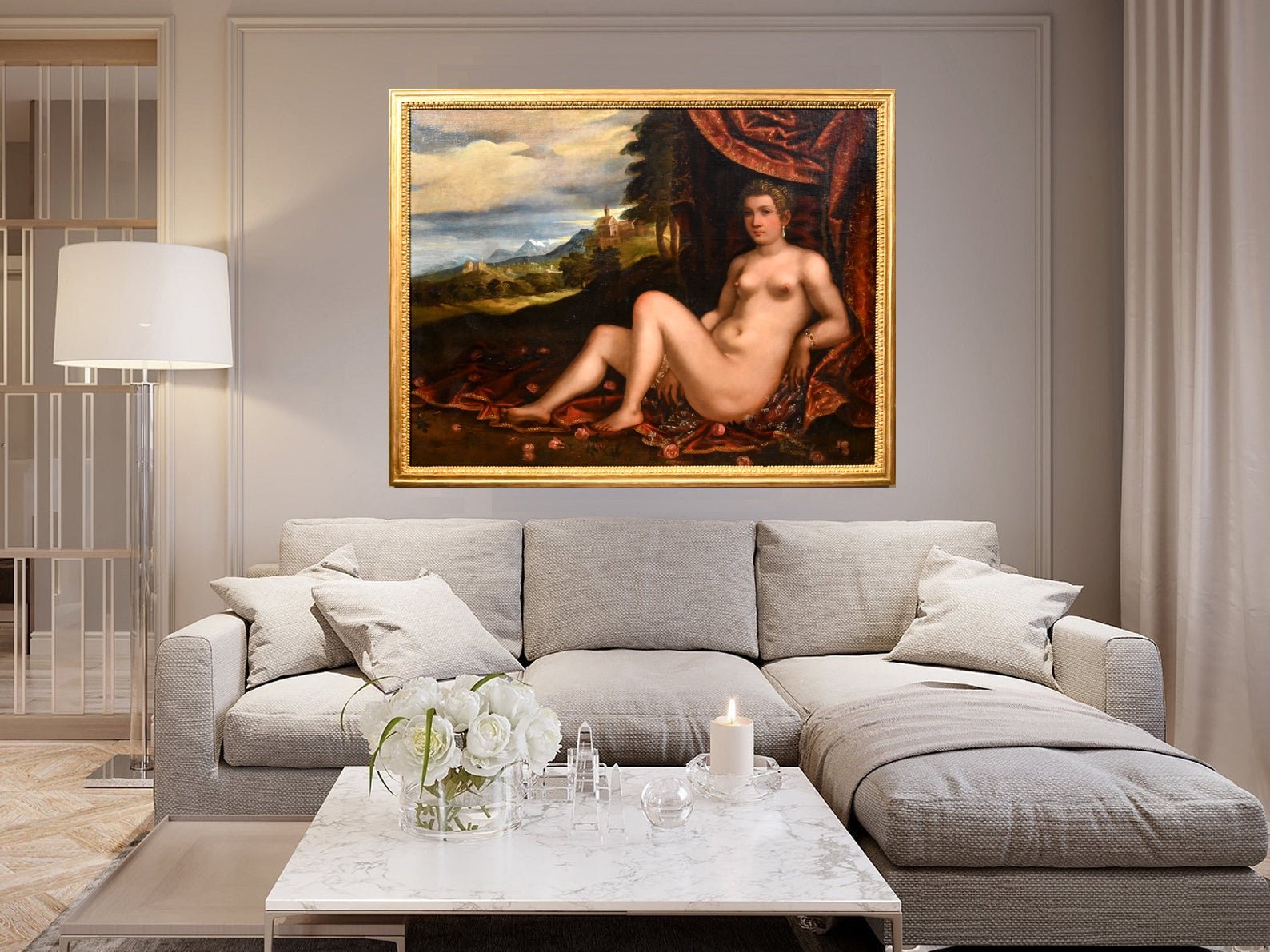Pauwels Franck detto Paolo Fiammingo (Anversa 1540 - Venezia 1596)
Ritratto di fanciulla come Venere
Pauwels Franck, known as Paolo Fiammingo
(Antwerp, 1540 - Venice, 1596)
Venus lying in a landscape
Oil on canvas 116 x 150 cm.
In antique frame 136 x 170 cm.
The work is accompanied by a critical card by Dr. Federica Spadotto
The splendid painting proposed sees portrayed, bare and stretched out on a red brocade cloth in gold sprinkled with roses, a refined and sensual Venus, in a composition with a profound symbolic value, and arriving at the perfect representation of the Renaissance woman who, like Venus, becomes an allegory love, eros, beauty and fertility.
The canvas is part of the prestigious Venetian artistic and cultural environment of the second half of the sixteenth century, whose distinctive distinctive trait can be traced back to its cosmopolitan vocation. This characteristic, as Dr. Spadotto noted in her in-depth study, belongs to the same physiology of the Venetian capital, that is, being a distinctly commercial city located in a strategic point with respect to trade. Representing one of the liveliest ports in the Mediterranean also meant witnessing the continuous passage not only of goods, but of men, ideas, suggestions from distant countries, which influenced not only the taste of their people, but above all art.
This happened thanks to the circulation of prints, as well as pictorial specimens, to which are added the stays of great foreign artists and, above all, the permanence in the capital of a non-negligible number of Dutch, Flemish and German masters.
An emblematic case in this regard comes from Pauwels Franck (Antwerp, 1540 - Venice, 1596), better known as Paolo Fiammingo, who established himself in his native city at a young age - in 1561 a figure enrolled in the Guild of San Luca - and arrived in Venice in 1573. .
He resided in Venice from 1584 until his death, although the stylistic and formal references of some of his works have led critics to believe that in previous years he had undertaken a journey to central Italy, or to Florence and Rome, where he would have metabolized the lively cultural debate that permeated these cities and which, on the other hand, seemed completely absent in Venice.
Here Paolo will be fascinated by the sense of color and by the atmospheric component fixed on the canvas by Jacopo Tintoretto (Venice 1518 - 1594), of which he becomes a collaborator, to undergo, around 1590, the suggestion of Paolo Caliari known as Veronese (Verona 1528 - Venice 1588), both from a coloristic point of view and with respect to precise guiding characters.
The painting in question stands as an illuminating figurative example of what has just been referred to, since it revisits the Venetian pictorial tradition through the Nordic filter, which is grafted onto a typical subject of the Renaissance repertoire. In the Venus in the foreground, with a typically Veronesian physiognomy, the reference to Venus with organist, cupid and dog performed by Titian (Pieve di Cadore, 1488-90-Venice, 1576) and now at the Staatlische Museum in Berlin appears a real homage to the great teacher. With the latter it shares the compositional layout, with the red curtain overlooking the goddess and the landscape in the background, although revisited in a strictly Nordic key, according to a modality that can be traced in the Venus with a dog of Ca 'Rezzonico, in Venice.
In this version of the theme, however, the author is still tied to the Flemish dictates, which in the large canvas under study are the complete synthesis of aesthetics between Northern Europe and the sensitivity of the lagoon. In the small flowers in the foreground and in the very enjoyable landscape backdrop that evokes the great Flemish masters, the very peculiar Venetian light is clearly perceptible: a real seal, together with the sky taken from Caliari, of the pictorial recipe developed by Pauwels. He creates a smooth cameo imbued with elegance, refinement and expressive happiness at the same time, in which the composed feminine beauty and the landscape reproduced with care in detail coexist with a quick, lively brushstroke imbued with light.
The painting is in excellent condition, with a beautiful antique frame.
The work is accompanied by a certificate of photographic authenticity in accordance with the law.
We take care and organize the transport of the purchased works, both for Italy and abroad, through professional and insured carriers. For any additional information, please do not hesitate to contact us.
Follow us also on:



